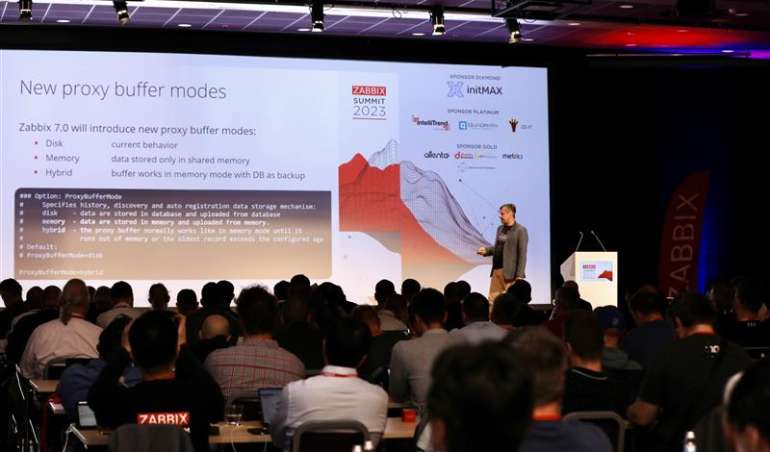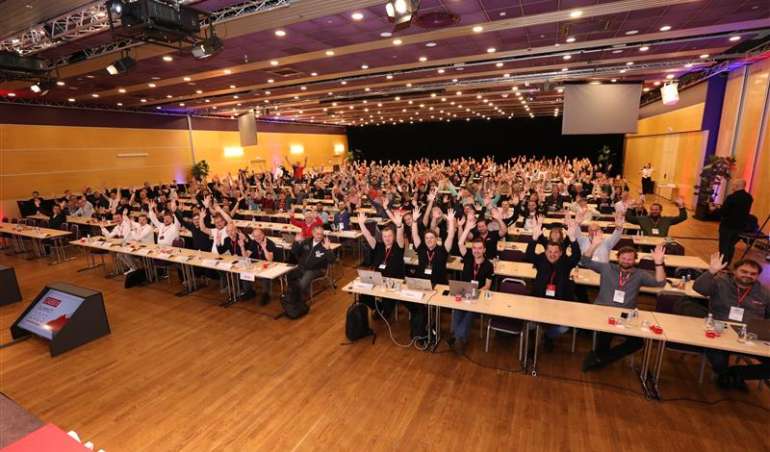Post Syndicated from Michael Kammer original https://blog.zabbix.com/a-look-back-at-zabbix-summit-2023/26744/
Autumn in the Latvian capital of Riga is marked by a variety of traditions. The leaves fall, the rainy season arrives, the birds migrate, and IT professionals from around the world descend on the city for the annual Zabbix Summit.
On October 6 and 7, the Radisson Blu Hotel Latvija was packed with 450 delegates from 38 countries, all there for Zabbix Summit 2023, the 11th in-person version of Zabbix’s premier yearly event.
This year’s Summit was marked by presentations, partner activities, and moments of relaxation and celebration that will energize the Zabbix community and spark ideas that attendees will take home to every corner of the world.
If you couldn’t make it, here’s a little taste of how it felt to be there!
Zabbix Summit 2023 in numbers
The stage hosted 27 speakers from 17 different countries who gave 31 speeches, including both lectures and lightning talks. There were four workshops with deep dives into technical topics, conducted by the Zabbix technical team as well as our partners from Opensource ICT Solutions and IZI-IT. Summit attendees also enjoyed three parties designed to provide a relaxing experience and networking opportunities.
Zabbix Summit 2023 proudly featured 10 sponsors, all part of Zabbix’s official partner network. They included:
initMAX – Diamond Sponsor
IntelliTrend – Platinum Sponsor
IZI-IT – Platinum Sponsor
Quadrata – Platinum Sponsor
Allenta – Gold Sponsor
Metricio – Gold Sponsor
Opensource ICT Solutions – Gold Sponsor
Docomo Business – Gold Sponsor
SRA OSS – Silver Sponsor
Enthus – Lunch and coffee break sponsor
We’d also like to give a shout-out to our Zabbix Fans, who played a crucial role in supporting the Summit this year (as every year) with their attendance, merchandise purchases, and enthusiasm!
We’re grateful to everyone who played a role and helped us make Zabbix Summit 2023 happen!
Highlights from the main stage
This year we continued a Summit tradition and allowed our in-person audience as well those tuning in via livestream and YouTube to ask questions during live Q&A sessions – a feature that made the proceedings more interactive and helped everyone feel more involved. The speeches were all fascinating and well received, but a few in particular stood out:
What the future holds for Zabbix
Zabbix CEO and Founder Alexei Vladishev kicked off the presentations on Day 1 with a keynote speech about his current plans for Zabbix’s development, including a detailed look at enhancements requested by users.
Avoiding alert fatigue
Bringing a less technical and more conceptual approach to addressing day-to-day data monitoring issues, Rihards Olups, SaaS Architect at Nokia, discussed alert fatigue and how science explains it. During his presentation, Rihards showed how an excess of alerts can negatively affect selective attention and shared his thoughts about how professionals can intervene to prevent problems.
Making Zabbix’s latest offerings accessible to everyone
Day 2 began with Zabbix Director of Business Development Sergey Sorokin focusing on new plans and offerings, including a subscription system for technical support, consulting services, and monitoring tailored for managed service providers.
Monitoring everything (and we do mean everything!)
Janne Pikkarainen, Lead Site Reliability Engineer at Forcepoint, provided detailed and entertaining insights into how he connects Zabbix to smart accessories and uses it to monitor aspects of his home, including the location of personal items, noise levels, and even the frequency of his daughter’s naps and cries.
Implementing ideas and design in MSP environments
In tackling the topic of data collection and analysis for service providers, Brian van Baekel, Zabbix Trainer at Opensource ICT Solutions, presented details on the development of projects focused on monitoring service providers. He also highlighted best practices for data collection in Zabbix Server, data storage, and presenting on the Zabbix Frontend.
Monitoring the London transportation system
A use case presented by Nathan Liefting, Zabbix Consultant and Trainer at Opensource ICT Solutions, and Adan Mohamed, DevOps Manager at Boldyn Networks, showed how Zabbix monitors the availability of the London Underground subway system. Data is collected from 136 “tube” stations in a high-level architecture and used to assess the availability of Wi-Fi networks, emergency connections, and other services.
Bringing the Olympics and World Cup to life with Zabbix
Marianna Portela, a Tech Lead at Globo in Brazil, shared her insights into how Zabbix supports Globo’s digital transformation and helps her monitor live event infrastructure at massive events like the Olympics and World Cup.
Don’t forget the fun part!
Zabbix Summits are renowned for their friendly, informal atmosphere, which is probably most clearly on display at our famous Summit parties.
Zabbix Summit 2023’s Welcome party was held at the Stargorod Riga brewery in the heart of Riga’s old town. It featured arm wrestling, a selection of delicious foods and beverages, and plenty of opportunities for Summit participants to get to know each other.
The Main party saw live music, dancing, quizzes, and other fun events take place within the historic confines of the Latvian Railway History Museum. The atmosphere, food, drinks, and good company all combined to create an event that nobody who attended will soon forget!
Last but not least, the Closing party at the Burzma food hall was a true celebration of the diversity of the global Zabbix community, with food and music from every country with a Zabbix presence as well as plenty of opportunities for Summit attendees to swap stories and exchange contact details.
Open door, open minds
The traditional Zabbix open-door day was held on Thursday, October 5, and while past Summits have typically seen around 50 visitors, we were proud to welcome closer to 100 this time around. Attendees could have a coffee with their favorite Zabbix employees, play a friendly game of foosball or table tennis, and get a behind-the-scenes look at where the magic happens.
Testify!
One new feature that made a big splash at this year’s Summit was the testimonial booth, which allowed Summit attendees to share their thoughts and experiences about Zabbix with the rest of our community. Sharing a testimonial or leaving a review allowed attendees to collect a piece of exclusive Zabbix Summit 2023 merchandise, and we went through a lot of it – the booth provided us with 28 filmed and 17 written testimonials about Zabbix products and services, far more than we anticipated.
Where to find the presentations
If you couldn’t attend but want to stay informed about what was discussed at the event (or if you’d just like to revisit the stage presentations), both days of recordings are available on Zabbix’s YouTube channel at the following links:
Streaming – Zabbix Summit Day 1
Streaming – Zabbix Summit Day 2
The graphics and texts of the presentations are also available for reference and download on the official event website.
We hope that Zabbix Summit 2023 was a time of valuable learning, connections, and idea exchange for everyone who attended or followed along through social media. If you’ve enjoyed the photos, you can see several more on our Instagram.
If you had an amazing time at Zabbix Summit 2023 (and we certainly hope you did), registration for Zabbix Summit 2024 is already open and Early Bird tickets are available.
See you next year!
The post A Look Back at Zabbix Summit 2023 appeared first on Zabbix Blog.






